
The Temptations are an American vocal group from Detroit, Michigan, who released a series of successful singles and albums with Motown Records during the 1960s to mid 1970s. The group's work with producer Norman Whitfield, beginning with the Top 10 hit single "Cloud Nine" in October 1968, pioneered psychedelic soul, and was significant in the evolution of R&B and soul music. The band members are known for their choreography, distinct harmonies, and dress style. Having sold tens of millions of albums, the Temptations are among the most successful groups in popular music.

Psychedelic Shack is the twelfth studio album by The Temptations for the Gordy (Motown) label released in 1970. Completely written by Norman Whitfield and Barrett Strong and produced by Whitfield, Psychedelic Shack almost completely abandoned the "Motown Sound" formula, instead delving fully into psychedelia. Along with the hit title track, the album also features the group's original version of "War", which became a major hit for Edwin Starr later in 1970.
"Hum Along and Dance" is a soul song written for the Motown label by Norman Whitfield and Barrett Strong. Originally recorded by the Temptations, the song was later covered by Motown acts Rare Earth and the Jackson 5. The song is essentially an instrumental piece and a vehicle for scatting and improvisational vocals, since, as the chorus states, "ain't no words to this song/you just dance and hum along". All three versions of the song were produced by Whitfield.
"That's the Way Love Is" is a 1967 Tamla (Motown) single recorded by The Isley Brothers and produced by Norman Whitfield.

Third Album is the third studio album released by the Jackson 5 on the Motown label, and the group's second LP released in 1970, on September 8.
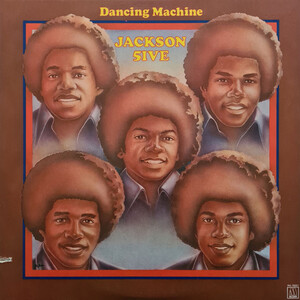
Dancing Machine is the ninth studio album released by the Motown quintet the Jackson 5, on September 5, 1974. The album's title track was a No. 2 pop hit and a No. 1 R&B hit in the United States. The group released two additional singles from the album: the funky "Whatever You Got, I Want" and the group's last US Top 20 hit for Motown, "I Am Love". To date, the Album "Dancing Machine" has sold approximately 2.6 million copies worldwide.
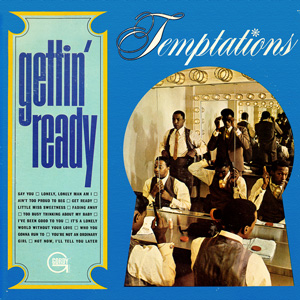
Gettin' Ready is the fourth studio album by The Temptations for the Gordy (Motown) label released in 1966. It marks the transition of the group from having Smokey Robinson as its main producer, with new producer Norman Whitfield taking over Robinson's position. Two #1 R&B hit singles, one from each producer, are included: "Get Ready" from Robinson with Eddie Kendricks on lead, and "Ain't Too Proud to Beg" from Whitfield with David Ruffin on lead. Also included is the original version of "Too Busy Thinking About My Baby," which would be rerecorded as a hit for Marvin Gaye in 1969. The album was also one of the last albums to contain tracks co-authored by members of the group until the release of The Temptations Do The Temptations (1976). As with previous Temptations albums, several songs are written by members of The Miracles: Smokey Robinson, Bobby Rogers, Pete Moore, Ronnie White, and Marv Tarplin.
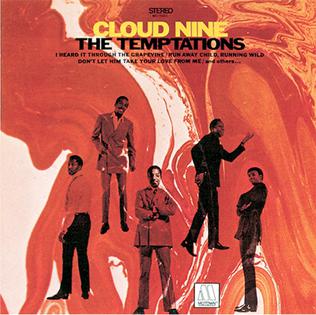
Cloud Nine is the ninth studio album by American musical group The Temptations for the Gordy (Motown) label released in 1969.
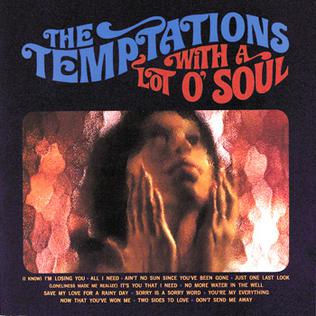
The Temptations with a Lot o' Soul is the fifth studio album by The Temptations for the Gordy (Motown) label released in 1967. Featuring four hit singles, With a Lot o' Soul is the most successful Temptations album from their "classic 5" era, during which David Ruffin, Eddie Kendricks, Paul Williams, Melvin Franklin, and Otis Williams constituted the Temptations' lineup.

Love Child is the fifteenth studio album released by Diana Ross & the Supremes for the Motown label in 1968. The LP was the group's first studio LP not to include any songs written or produced by any member of the Holland–Dozier–Holland production team, who had previously overseen most of the Supremes' releases.

Temptations Live! is the first live album to be released by The Temptations. The album was recorded on October 3, 1966, at the Roostertail in Detroit, Michigan. The album cover photograph was taken in March 1966 at The 20 Grand, 14th and Warren in Detroit, Michigan, and the album was released on Gordy (Motown) Records in 1967. The album features David Ruffin, Paul Williams, Eddie Kendricks, Melvin Franklin, and Otis Williams performing their regular live repertoire for a highly receptive crowd mostly consisting of young women. Included in the set are Temptations hits such as "My Girl", "My Baby", "Get Ready", "Ain't Too Proud to Beg", "Don't Look Back", and the group's then-current single, "Beauty Is Only Skin Deep". Out of the several live albums the group recorded during their career, this is the only one to feature David Ruffin. The album remained on the Billboard pop albums chart for 51 weeks, peaking at number 10.

The Temptin' Temptations is the third studio album by The Temptations for the Gordy (Motown) label released in 1965. The album includes several of the group's hits from 1965, and also includes a handful of singles that were not included on the Temptations' first 1965 album, The Temptations Sing Smokey. Among these are the 1964 singles "Girl " and "I'll Be in Trouble"; and the 1965 singles "Since I Lost My Baby", and "My Baby". Seven of the album's 12 tracks had previously been released as singles and their B-sides, though "My Baby" preceded the album only by a month.
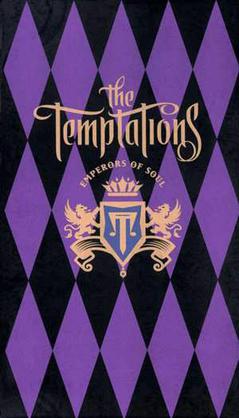
Emperors of Soul is a 1994 box set compilation for The Temptations, released by Motown Records. The five-disc collection covers the Temptations' entire four-decade history, from the first recording of The Distants in 1959 to four new recordings by the then-current Temptations lineup of Ali-Ollie Woodson, Theo Peoples, Ron Tyson, and stalwart members Otis Williams and Melvin Franklin.
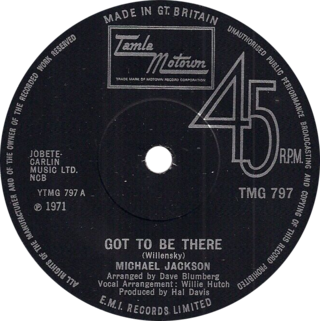
"Got to Be There" is the debut solo single by the American singer Michael Jackson, written by Elliot Willensky and released as a single on October 7, 1971, on Motown Records. The song was produced by Hal Davis and recorded at Motown's Hitsville West studios in Hollywood.
"Everybody Needs Love" is a 1964 Motown song by Norman Whitfield and Edward Holland, Jr. The first version released was by The Temptations for their album The Temptin' Temptations in 1965, but the most successful version was on a single by Gladys Knight & the Pips, which peaked at #39 on the Billboard Hot 100 chart, and #3 on the Billboard R&B singles chart, in 1967. Other Motown acts that recorded this song were Mary Wells, which featured Eddie Kendricks of The Temptations in the background, Jimmy Ruffin, The Velvelettes, and The Miracles. All versions of the song were produced by Whitfield.
"Farewell My Love" is a 1963 single by The Temptations for the Gordy (Motown) label. It was the last single that was written and produced by Motown president Berry Gordy for well over a decade, and the last released during the period of the "Original 5" lineup. It is also noted as the group's last single to miss the Billboard pop chart's Top 40 until 1971's "It's Summer". Up until now the group was jokingly referred to at this time as the "Hitless Temptations" by the Motown staff, much like their "sister" group, The Supremes, were called the "no-hit Supremes". However, their next single, the Smokey Robinson-produced "The Way You Do the Things You Do", would reach the Top 20 of the U.S. pop chart, breaking the group's streak of being "hitless".

Joyful Jukebox Music is a compilation album by American music group the Jackson 5, released by the Motown label on October 26, 1976, after the band had left the label. This is the third compilation released by the group, after Greatest Hits (1971) and Anthology (1976), yet the first to be entirely composed of previously unreleased material, recorded between 1972 and 1975. The compilation was released less than two weeks before the group's debut on their new label Epic Records.
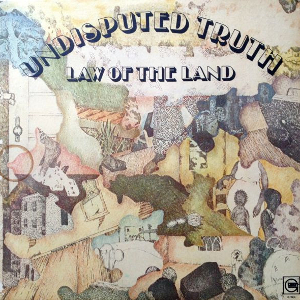
Law of the Land is the third album by the Norman Whitfield's Motown group The Undisputed Truth.

Come And Get It: The Rare Pearls is a compilation album of previously unreleased tracks by American family group The Jackson 5, which was released digitally on August 28, 2012 and physically on September 18, 2012.
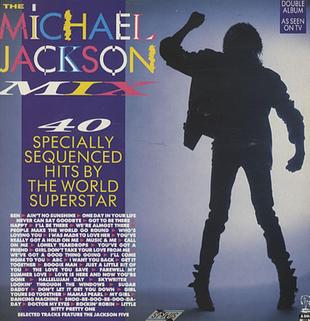
The Michael Jackson Mix is a compilation album by American singer and recording artist Michael Jackson, released in 1987. Available as a double LP, double cassette and double CD, the album contains 40 songs from Jackson's Motown career – solo and with The Jackson 5 – edited together in four separate megamixes: "Love Mix 1" and "Love Mix 2" on the first LP, cassette and CD, and "Dance Mix 1" and "Dance Mix 2" on the second LP, cassette and CD.
















